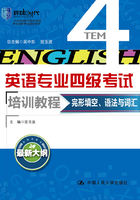
五、2009年专四完形填空真题与解析
【真题操练】
PART III CLOZE [15 MIN]
Scientists around the world are racing to learn how to rapidly diagnose, treat and stop the spread of a new, deadly disease. SARS—Severe Acute Respiratory Syndrome—was(31)______ for the first time in February 2003 in Hanoi, (32)______since then hasinfected more than 1,600 people in 15 countries, killing 63. At this (33)______, thereare more questions than answers surrounding the disease.
Symptoms start (34) ______a fever over 100.4 degrees F, chills, headache or body(35)______ . Within a week, the patient has a dry cough, which might (36)______ to shortness of breath. In 10% to 20% of cases, patients require (37)______ventilation to breathe. About 3.5% die from the disease. Symptoms (38)______ begin in two to seven days, but some reports suggest it (39)______take as long as 10 days. Scientists are close to (40)______a lab test to diagnose SARS. In the meantime, it is diagnosed by its symptoms. There is no evidence (41)______antibiotics or anti-viral medicines help,(42)______doctors can offer only supportive care. Patients with SARS are kept in isolation to reduce the risk of (43)______Scientists aren’t sure yet, but some researchers think it’s a(44)______discovered coronavirus, the family of viruses that cause some common colds.
Most cases appear to have been passed (45)______droplets expelled when infectedpatients cough or sneeze. Family members of infected people and medical workers whocare (46)______ them have been most likely to (47)______the illness. But recent developments in Hong Kong suggest that the (48)______ might spread through air, or that the virus might (49)______ for two to three hours on doorknobs or other (50)______ .Health experts say it is unlikely, though, that sharing an elevator briefly with an infected personwould be enough to pass the virus.
31. A. detected B. caught C. disclosed D. revealed
32. A. but B. and C. or D. yet
33. A. time B. point C. aspect D. instance
34. A. from B. over C. upon D. with
35. A. hurt B. sore C. aches D. feelings
36. A. process B. advance C. progress D. convert
37. A. automatic B. artificial C. mechanical D. controlled
38. A. regularly B. ordinarily C. traditionally D. generally
39. A. will B. might C. should D. must
40. A. cultivating B. fostering C. developing D. designing
41. A. which B. that C. whether D. what
42. A. so B. but C. still D. yet
43. A. communication B. transportation C. transformation D. transmission
44. A. lately B. newborn C. newly D. renewed
45. A. under B. through C. beneath D. from
46. A. for B. over C. after D. about
47. A. acquire B. receive C. obtain D. contract
48. A. ailment B. ill-health C. disease D. infection
49. A. continue B. linger C. delay D. persist
50. A. exteriors B. outside C. surfaces D. coverings
【文章大意】
本篇为说明文,主要介绍了非典病毒的症状和传播情况。第一部分(1):整体介绍非典病毒的发现、感染和研究现状。第二部分(2):感染非典病毒后的症状。第三部分(3):非典病毒的传播途径。
【答案详解】
31. A 动词词义辨析。【解析】 “detect”:发现;察觉(可表示通过某种手段发现或觉察到某物);“catch”:捕捉到;领会( “catch a cold”:患了感冒);“disclose”:揭露;说出; “reveal”:揭露;泄漏(指把原来鲜为人知的事公诸于众)。这里是说检查发现出第一例非典病例,故选 A。
32. B 逻辑关系判断。【解析】空白处前一句介绍了第一例非典在何时何地被发现,后一句说明了非典蔓延的情况,两句间是并列顺承的关系,故选 B。
33. B 固定词组搭配。【解析】 “at this point”:到这个时候;在这时(表示事情发展到某个特殊时间或阶段);“at this time”:这时(使用时需要有明确的具体时间指向);“aspect”:方面;层面(通常与“ from”搭配,构成“ from this aspect”:从这个层面上);“instance”:例子;实例(通常与“ for”搭配,构成“ for instance”:例如)。故选 B。
34. D 固定词组搭配。【解析】 “start with”:以……开始( “with”表示伴随,表示事情发展之初的某种状态);“start from”:从(某处或某水平)开始(只表示动作的一个起始点,不表状态);“over”不可与“ start”搭配使用; “start upon/on”:开始做某事(其后一般接名词,如“ start on your homework”:开始写作业)。此句意为:起初的症状是华氏 100.4°以上的高烧、感冒、头痛或全身疼痛。故选 D。
35. C 名词词义辨析。【解析】 “hurt”:伤害(一般用来指精神上的痛苦或创伤);“sore”:(身体上的)伤口,感染等造成的红肿,化脓等引起的疼痛; “ache”:(单纯身体上的)疼痛; “feelings”:感情;情绪。 “body aches”(固定搭配):身体(多处)疼痛。故选 C。
36. C 动词词义辨析。【解析】 “process”:处理,加工; “advance”:提高;提升;提前(一般表示在价值、级别、价格或重要性上的提高,以及在时间上的提前,如“advance the cause of democracy”:推进民主事业);“progress”:继续进行;继续发展(可表示在时间或地理位置上的行进,也可表示在复杂程度、范围或严重程度上的进步发展,如“ the rapid progression of disease”:病情的迅速发展);“convert”:转变;皈依(指事物形式或功能上的改变、度量衡的转换以及人的思想的转变,如“convert a criminal”:改造罪犯)。原文想要表达的意思是病情的发展恶化,故选 C。
37. C 形容词词义辨析。【解析】 “automatic”:自动的;不假思索的;无意识的;“artificial”:人造的;虚假的,矫揉造作的; “mechanical”:机械的,力学的;呆板的;“mechanical ventilation”:呼吸机(医学用语,是一种帮助病人呼吸的医学器械);“controlled”:受约束的,克制的。由上下文可知,病人出现呼吸困难,需要辅助呼吸的器械,故选 C。
38. D 副词词义辨析。【解析】 “regularly”:有规律地;定期地(表示规律性);“ordinarily”:平常地;普通地; “traditionally”:按传统来说;惯例地; “generally”:通常地;大体上(表示事物发生的普遍性)。根据文中“ but”一词,可知前后两句是转折关系,表达相反的意思,后一句说有些人的症状可能长达 10天才会出现,说明了一种特殊的状况,那么前一句必然表示“通常地,一般地”,故选 D。
39. B 情态动词辨析。【解析】 “will”:将;愿意(表示将要进行的动作或一种意愿);“might”:可能(表示一种较小的可能性);“should”:应该;得(可用于虚拟语气);“must”:必须(表示一种较强烈的语气)。根据上下文可知,前一句说症状通常的潜伏期为 2到 7天,后一句说也有长达 10天的,是一种特殊情况,应该表示一种较小的可能性;此外,本句中“ suggest”意为“显示,表明”,而不是“建议”,所以从句中不可用虚拟语气。故选 B。
40. C 动词词义辨析。【解析】 “cultivate”:培育;教育(通常指培育农作物或通过教育或训练提高素质等);“foster”:促进;培养(指养育后代或指想法的形成);“develop”:发展;开发;研制(表示着手开发或研制某种东西或开发某个项目,也可指产生新想法,设计新产品);“design”:设计;计划;设想。文中此处的句意为:科学家们快要开发出一个实验室测试的方法来诊断非典。故选 C。
41. B 同位语从句。【解析】 “There is no evidence that…(= There is no proof that…)”为常用表达, “that”引导“ evidence”的同位语从句,意为“没有证据来证明……”,故选 B。
42. A 逻辑关系判断。【解析】空白处前一句中提到还没有证据能证明抗生素和抗病毒药物能有所帮助,下一句说医生只能提供支持性治疗。很明显这两句间是因果关系,故选 A。
43. D 名词词义辨析。【解析】 “communication”:交流,传达(一般用于人际交往和通讯联络);“transportation”:交通运输;运送; “transformation”:改变,改观(可表示观点、方式或性质的彻底变革);“transmission”:传播;传染;传达(表示人际间或地域间事物的传递、疾病的传播,也可表示电子信号、广播等的播送)。此句意为:隔离感染 SARS的病人是为了减小病毒传播的可能性。故选 D。
44. C 近义词辨析。【解析】 “lately”:adv.近来,不久前(一般用于现在完成时);“newborn”:adj.新生儿的;新生的; “newly”:adv.最近地,最新地; “renewed”: adj.更新的;复兴的。本句意为:科学家们还不能确定,但一些研究人员认为 SARS是一种新发现的冠状病毒。故选 C。
45. B 固定词组搭配。【解析】 “pass under/beneath”:从……底下经过,如 Water passes beneath/under the bridge.(水从桥下流过);“pass through”:经过;路过;通过(某种方式);“pass from…to…”:从……转变为……,如 pass from a solid state to a liquid state(从固态变成液态)。本句意为:大多数病例是通过非典患者咳嗽或喷嚏产生的飞沫而被感染的。故选 B。
46. A 固定词组搭配。【解析】 “care for”:照顾,看护,照看; “care about”:关心,在意;介词“ over”和“ after”均不可与“ care”构成固定词组。此空白处意为照料患者的医护人员。故选 A。
47. D 动词词义辨析。【解析】 “acquire”:(通过努力、能力、行为表现)获得,得到,如“ acquire knowledge”(获得知识);“receive”:收到;遭到; “obtain”:(经过努力)获得,赢得,如“ obtain achievement”(取得成就);“contract”:订阅;使缩短;感染(疾病),如“ contract AIDS/virus/a disease”(感染艾滋病 /病毒 /疾病)。故选 D。
48. C 名词词义辨析。【解析】 “ailment”:微恙;小病; “ill-health”:不健康;“disease”:(泛指)疾病; “infection”:感染;传染病。由于前文一直都只在讨论非典这种疾病的传播,所以此处指代的就是非典这种传染病,故选 C。
49. B 动词词义辨析。【解析】 “continue”:继续; “linger”:逗留,继续存留;“delay”:延迟;耽搁; “persist”:坚持,持续。本句意为:这种病毒很可能在门把手上存活两到三个小时。故选 B。
50. C 名词词义辨析。【解析】 “exterior”:(建筑物的)外观,外部;(人的)外貌; “outside”:外部;周围;外缘; “surface”:表面(指任何物体的表面或最外面一层);“covering”:覆盖物;材料。根据“ or”和“ other”可推断出空白处的词应与“doorknobs”在意思上构成并列关系,表示“在门把手或其他物体表面”。故选 C。